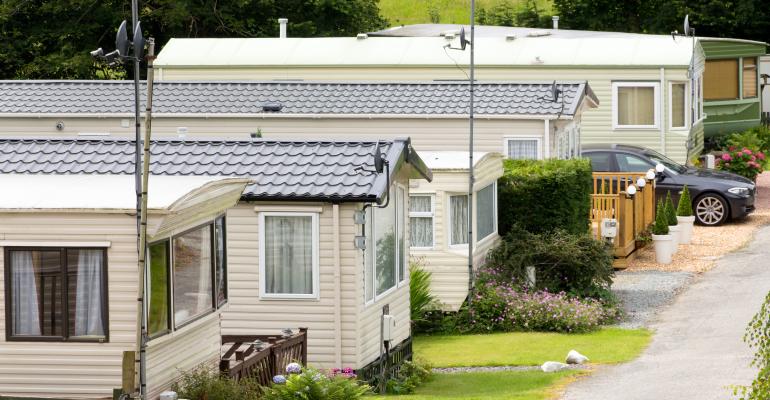REITs in the infrastructure, data center and industrial sectors have been basking in REIT glory for some time, but manufactured home REITs deserve some attention too.
Last year, the three publicly-traded manufactured home REITs posted overall returns of nearly 25 percent, according to trade group Nareit—behind the performance of infrastructure and data center REITs, but ahead of industrial REITs. The total gains of manufactured home REITs in 2017 outperformed those of office, retail, multifamily, hotel and health care REITs.
This year, those three REITS—Chicago-based Equity LifeStyle Properties Inc., Southfield, Mich.-based Sun Communities Inc. and Freehold, N.J.-based UMH Properties Inc.—are expected to continue chugging right along. Here are examples of their growth plans in 2018:
- During the first quarter, Equity LifeStyle spent $48.2 million to purchase two manufactured home communities in Florida with a total of 654 homesites.
- Sun Communities is on track to add 1,000 homesites at 12 manufactured home communities.
- UMH intends to buy six manufactured home communities with about 2,200 homesites for a total of $75.5 million.
“The manufactured housing sector is one of the hottest real estate sectors. Our property type has finally been recognized as the relatively recession-resistant and stable income generator that it has been for UMH for the past 50 years,” Samuel Landy, president and CEO of UMH, told Wall Street analysts on May 10. This year, the manufactured home sector is poised to get even hotter as the federal government considers easing regulations and as more emphasis is placed on affordable housing.
“The near-term operating outlook remains very favorable for the manufactured housing REITs,” says Ryan Lumb, a REIT analyst at Green Street Advisors LLC, a commercial real estate research and advisory firm based in Newport Beach, Calif.
“Strong demand from an affordability-minded consumer and essentially no new development provide unique underpinnings relative to other property sectors,” Lumb adds. “We anticipate revenue growth will be well above other property sectors, with the exception of industrial, which is benefiting from the massive e-commerce tailwind.”
Manufactured housing REITs could get a massive tailwind from potential relaxation of manufactured home rules issued by the U.S. Department of Housing and Urban Development (HUD). In January, HUD said it was reviewing federal regulation of manufactured homes in an effort to boost the availability of affordable housing while ensuring consumer protections are in place. That review could lead to deregulation of the industry.
In addition, federally-backed lenders Fannie Mae and Freddie Mac are exploring pilot programs to offer secondary financing for manufactured homes, says Brad Johnson, managing partner of Park Street Partners and Evergreen Capital, two Ladera Ranch, Calif.-based companies in the manufactured home industry. Secondary financing would be a boon to the sector, as it would increase financing options while cutting interest rates for buyers of manufactured homes, he says.
Whatever happens with the HUD rules and with secondary financing, manufactured home REITs still could see a bounce from escalating interest in affordable housing.
In a January 2018 report, the non-profit Urban Institute explained that manufactured housing is the least expensive type of housing and questioned why more manufactured homes aren’t being built. The average cost per sq. ft. for a manufactured home is $57.21, according to the report, compared with $87.76 for an existing site-built home and $108.10 for a new site-built home.
U.S. shipments of manufactured homes climbed by 14.4 percent from 2016 to 2017, according to the Manufactured Housing Institute, an industry trade group. However, the number of manufactured homes shipped last year is a far cry from the annual average of 242,000 from 1977 to 1993, the Urban Institute report notes. On a hopeful note, the Urban Institute anticipates production of manufactured homes will “gradually increase” over the next several years, although restrictive zoning continues to hamper establishment of new manufactured home communities in urban and suburban areas.
In the meantime, manufactured home REITs are reaping the rewards of rising awareness of the sector.
Just as has happened with the self-storage sector, REITs specializing in manufactured home communities—what some people still might call trailer parks or mobile home parks—have introduced a professional management approach, according to Brad Case, senior vice president of research and industry information at Nareit. Furthermore, the perception of the industry has vastly improved, he adds, thanks in part to the jazzed-up appearance and amenities of manufactured homes.
Johnson says manufactured home REITs are “unbelievably reliable businesses.” To highlight that point, he notes that Equity LifeStyle Communities has notched NOI growth in every quarter since 1998.
“This would be impressive in any 20-year period, but considering this timeframe happened to include a nuclear-bomb housing crisis, it’s downright amazing,” says Johnson, whose two businesses own, operate and invest in manufactured home communities.
Over the long haul, a buy-and-hold investor in manufactured housing stands to earn the top risk-adjusted returns (8.1 percent) among all commercial real estate types, according to a May 2018 report from Green Street Advisors.
Johnson says the manufactured home sector is being buoyed by the wave of retiring baby boomers, many of whom aren’t financially prepared for life after work; a tight supply of manufactured home communities; and stagnant wage growth coupled with a spike in housing costs.
“Counterintuitively, the risk to manufactured housing REITs’ underperformance is not a recession, but a booming economy,” he says. “Loose credit standards of the late 1990s to early 2000s, when anyone with a pulse could qualify for a large stick-built home, hurt manufactured housing. Given current national debt levels and low GDP growth, that appears to be a very low probability risk over the next decade.”





